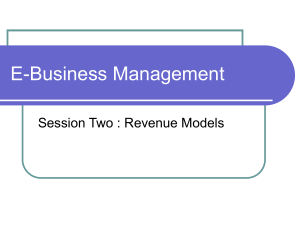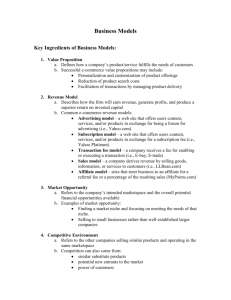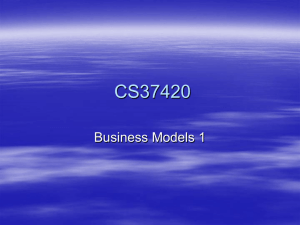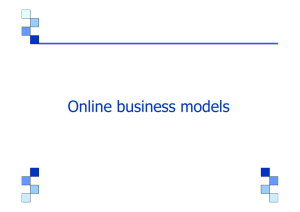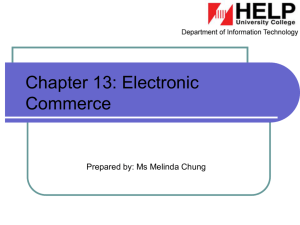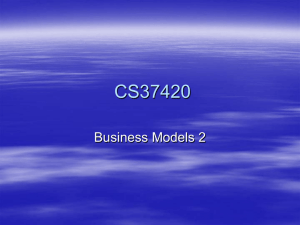File
advertisement
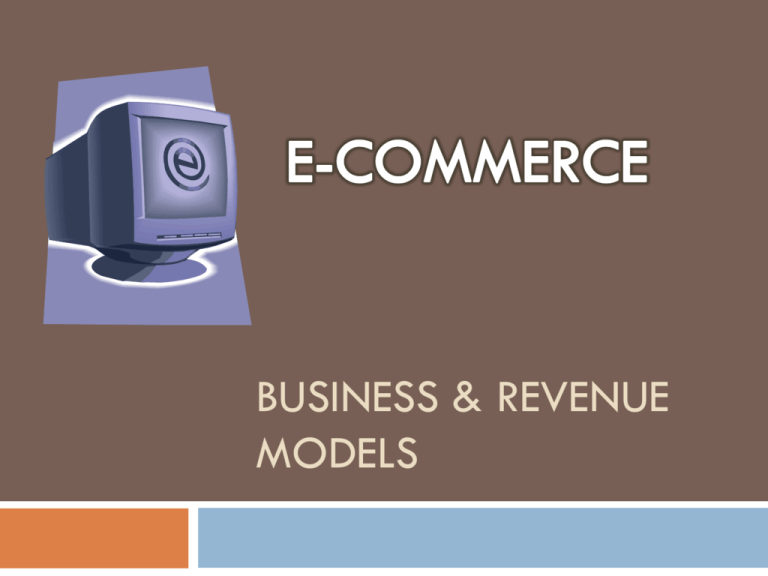
BUSINESS & REVENUE MODELS BUSINESS MODELS business model involves the following choices: 1. Value proposition – how to deliver value to the customer 2. Market offering – what will sell, where, … 3. Resource system – what facilities, … 4. Financial model – how will you charge for your product or service Value Proposition Choice of target segment Choice of what benefits you will offer Choice of capabilities Market Offering Identify scope of the offering Address customer decision process Match product/services to customer decision process: What resources to deploy ? Resource system shows how a co must align its internal “systems” and partners to deliver the benefits of the value proposition Financial Models Revenue Model Shareholder value models Growth models Revenue Models P roduct/service information (infomediary) A dvertising (Google Adwords, Adsense) S ale/transaction (eCommerce – buy/sell) S ubscription (to a service – Bloomberg, Dunn & Bradstreet, Prowess DB, …) Shareholder Value Models User Derived: Metamarket- hub for many buyers/sellers, multiple categories; e.g., BabyCenter.com Auctions- competitive bid hub: eBay, Freemarket Category switchboard- aggreg brands: PlanetRX Company Derived: Best Information- Zagat, NYTimes Wildest assortment- Secondspin.com Lowest Price- Buy.com, Lowestfares.com Most Personalized- Reflect.com Revenue Growth Models Deeper penetration into current market (existing product) New product development (existing market) New market development (existing product) New products and new markets On-line and off-line space Types of e-business models generally they are classified on the following basis :1. 2. Parties connected e.g B2B, B2C etc transaction types business models : transaction types Brokerage Value chain Manufacturer Info-mediary Advertising Subscription Affiliate Community Low CONTROL High Aggregator Low VALUE INTEGRATION High Agregator Model Virtual Merchant – Pure Play e-tailers (Amazon) Catalog Merchant – Levenger Bit Vendor – Avast Surf-and-turf Brokerage Model Buy/Sell Fulfillment (eTrade,TradeIndia) Trading Community (VerticalNet,Goozex) Distributor (ConvergeTrade) Metamediary (Zshops) Reverse Auctions (priceline.com) Bounty Broker Market Exchange (ChemConnect) Buyer Aggregator Virtual Mall (Yahoo!Store) Auction Broker (eBay) Classifieds Search Agent (DealTime) Value Chain Model Value chain moves business away from discrete streams of data about the product being made to one unified pool of information Infomediary Model Recommender System – ePinions Registration Model – NYTimes.com Advertising Model Generalized Portal – AOL Personalized Portal – MyMSN Specialized Portal / Vortal Attention/Incentive Marketing – CyberGold Free Model – Blue Mountain Bargain Discounter – Buy.com Other Models Manufacturer Model – Intel, Apple Affiliate Model -Banner Exchange, Pay-per-click, -Revenue Sharing Community Model: - Voluntary contributor model (NPR) - Knowledge Networks (Deja, Guru, ..) Subscription Model (WSJ) Utility Model – use based business models: parties involved B2B (Business-to-Business) B2C (Business-to-Consumer) C2B (Consumer-to-Business) C2C (Consumer-to-Consumer) Revenue Model Revenue Is the amount of money that a company actually receives during a specific period, including discounts and deductions for returned merchandise. It is the "top line" or "gross income" figure from which costs are subtracted to determine net income. Revenue = Price of goods and services X no. of units Five Cases revenue models: Advertising model Subscription model Transaction fee model Sales model Affiliate model Advertising model Simply you have website and provides a contents and forum for advertisements and get fees from advertisers. The advertising model is an addition of the traditional media model. The web site, provides content which always free and services like email, IM, blogs and users accepts advertising messages in the form of banner ads. To attract users to its site, leading Web portal Yahoo! offers things like free e-mail, extensive content, and travel services. The firm got its start in early 1995 when founders Jerry Yang and David Filo put together a simple list of favorite Web sites. Subscription model A company offers it users content or services and charges a subscription fee for access to some or all of it offerings. where a customer must pay a subscription price to have access to the product/service. The model was pioneered by magazines and newspapers, but is now used by many businesses and website. Industries that use this model include mail order book sales clubs and music sales clubs, cable television, satellite television providers with pay-TV channels, satellite radio, telephone companies, cell phone companies, internet providers, software providers, business solutions providers, financial services firms, fitness clubs, and pharmaceuticals, as well as the traditional newspapers, magazines and academic journals. Transaction fee model There are businesses offering services for which they charge a fee based on the number or size of transactions they process. The business provides information to the customers which is required to complete a transaction and revenue is purely earned on that basis. For example, online travel agents receive a fee for facilitating a transaction that includes the making of travel arrangement for their clients, as well as, advising them about lodging, transportation etc. Stock brokerage firms also use this model as they charge their customers a commission for each transaction of stocks/shares executed through them. Sales model A company derives revenue by selling goods, information, or services. Here the merchants provide goods and services online but based on list prices or via auction. Examples: wwww.1800flowers.com This site sells the flowers online, and deliver your order almost everywhere in US. Affiliate model A company steers business to an affiliate and receives a referral fee or percentage of the revenue from any resulting sales. Example: www.movies.com This site uses Amazon Associates Web Services to deliver a complete marketplace of DVDs.
